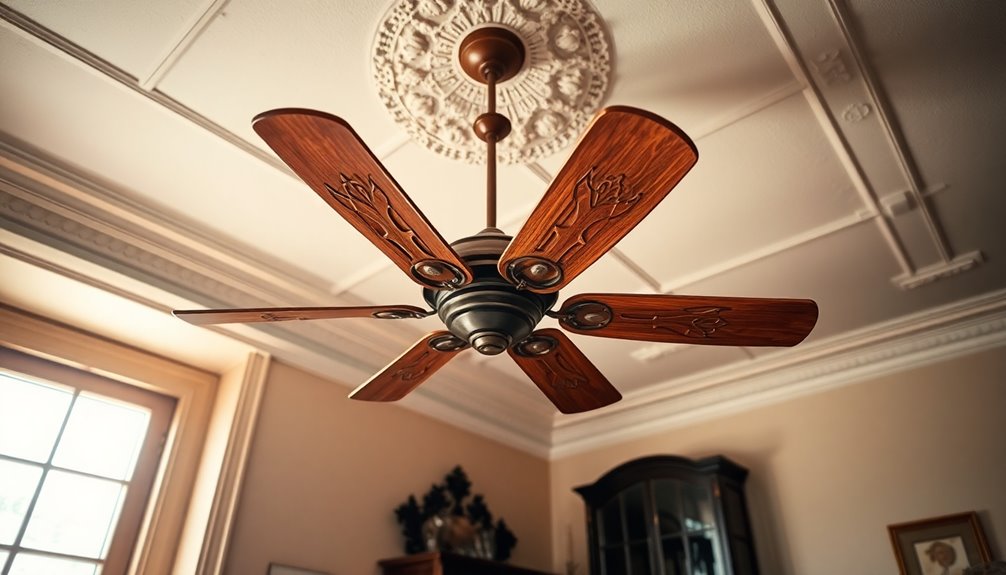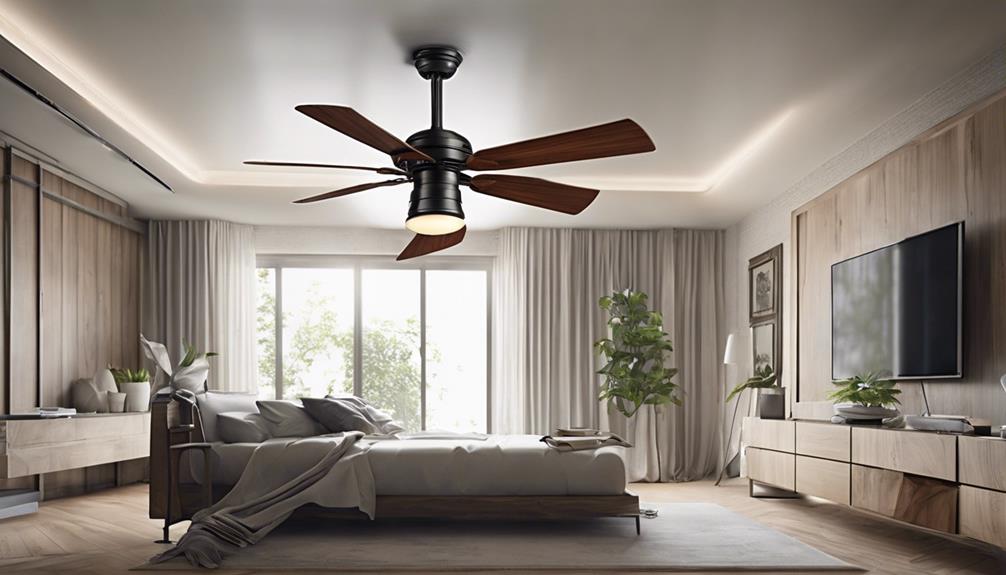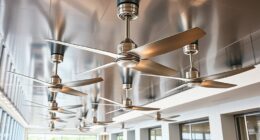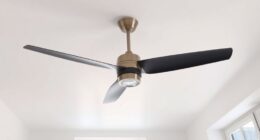Ceiling fans first appeared in West Asia around the 6th century B.C. They gained popularity in the 17th century with the hand-operated punkah in India. In the U.S., ceiling fans emerged in the 1860s, initially powered by water and turbines. The breakthrough came in 1882 when Philip Diehl invented the electric ceiling fan, changing how households cooled their spaces. By the 1920s, ceiling fans became standard in homes, particularly upscale ones. Despite fluctuations in popularity over the years due to air conditioning, they remain effective and efficient. Curious about their modern innovations and features? You'll find more fascinating details ahead!
Key Takeaways
- Early versions of ceiling fans appeared in West Asia around the 6th century B.C.
- The first ceiling fans in the U.S. emerged in the 1860s, powered by water and turbines.
- Philip Diehl invented the electric ceiling fan in 1882, marking a significant development in fan technology.
- Electric ceiling fans became popular in homes during the 1920s, particularly in upscale residences.
- The use of ceiling fans declined during the Great Depression and post-WWII, but saw a resurgence in the 1970s due to energy concerns.
Origins of Ceiling Fans
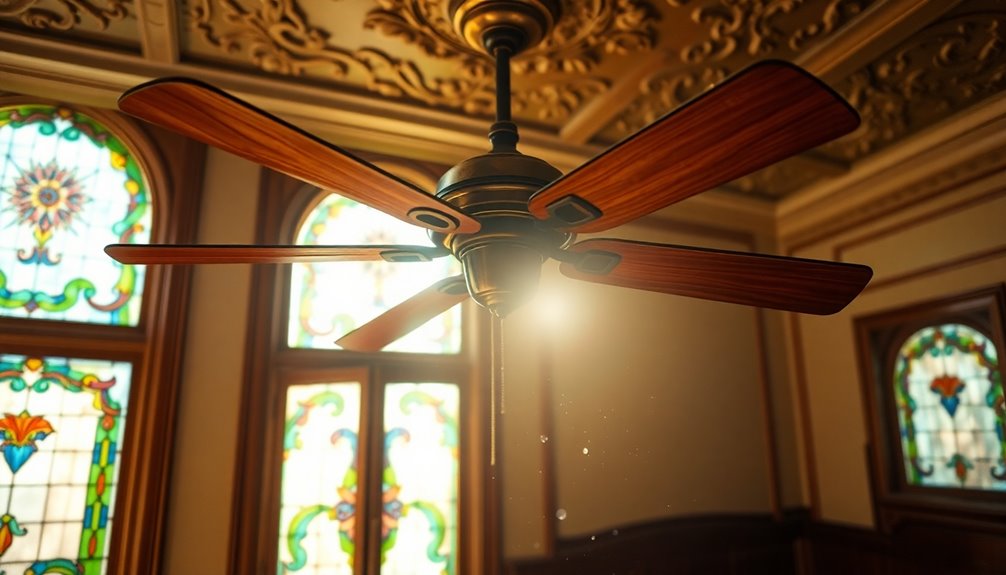
The origins of ceiling fans date back to ancient civilizations, with early versions possibly emerging in West Asia around the 6th century B.C. These primitive designs laid the groundwork for what would evolve into modern ceiling fans.
By the early 17th century, in India, the punkah became popular; this hand-operated fan made of palm leaves or cloth was used to improve air circulation in homes.
The first ceiling fans in the United States appeared in the early 1860s, featuring two blades powered by running water and turbines. This innovation marked a significant advancement in cooling technology.
However, the true revolution came in 1882 when Philip Diehl invented the electric ceiling fan, utilizing a sewing machine motor. This invention transformed ceiling fans from luxury items into practical appliances for everyday use.
Early Development in the U.S
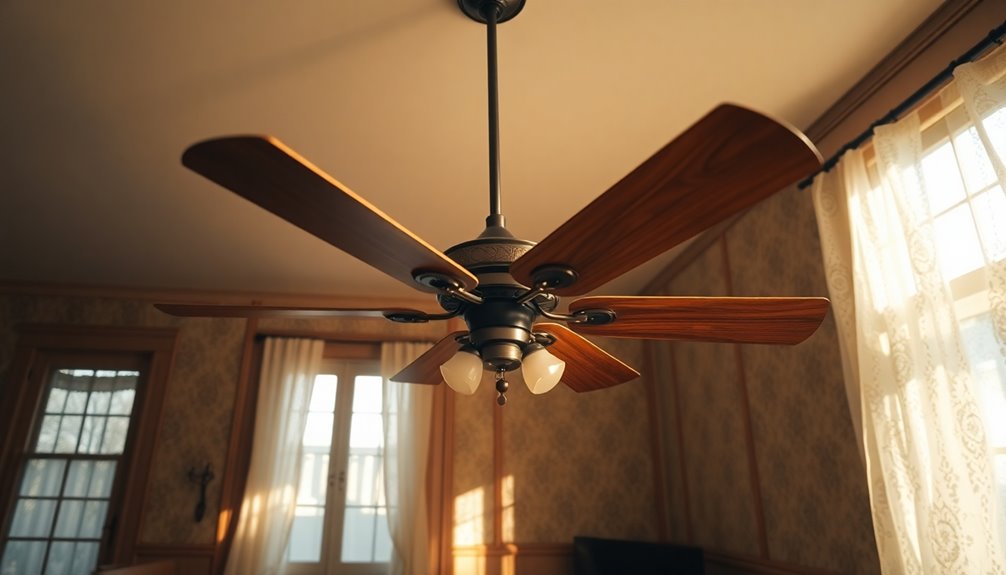
While early ceiling fans in the U.S. emerged in the 1860s, their development quickly evolved with innovations in design and technology. The first ceiling fans appeared as non-electric models, powered by a belt system utilizing water or steam energy. However, the landscape changed dramatically with the invention of the electric motor. In 1882, Philip Diehl created the first electric ceiling fan using a sewing machine motor, paving the way for modern cooling solutions.
In 1886, John Hunter and his son took fan technology a step further by introducing a water-powered, belt-driven ceiling fan through the Hunter Fan Co. By World War I, ceiling fans shifted to four-blade designs, enhancing their efficiency considerably.
To illustrate the progression:
| Year | Development | Key Invention |
|---|---|---|
| 1860s | Non-electric ceiling fans | Belt system |
| 1882 | First electric ceiling fan | Sewing machine motor |
| 1886 | Advancements by Hunter Fan Co | Water-powered fan |
| WWI | Shift to four-blade design | Improved cooling |
| 1920s | Rise in residential use | Upscale Southern homes |
As air conditioning became common, ceiling fans remained a popular choice among fans in the United States.
Rise in Popularity

As ceiling fans evolved throughout the early 20th century, they started gaining traction in American homes, particularly during the 1920s. They became a staple in affluent households, showcasing both style and functionality.
However, the onset of the Great Depression in the 1930s took a toll on ceiling fan sales as household spending decreased dramatically. Many families had to prioritize essentials, and the luxury of ceiling fans fell by the wayside.
Post-World War II, air conditioning emerged as the go-to cooling solution in the 1950s, further diminishing ceiling fan usage.
Yet, the 1970s energy crisis marked a turning point. Consumers began looking for cost-effective alternatives to combat rising energy costs, leading to a resurgence in ceiling fan popularity.
Impact of Air Conditioning

Air conditioning drastically changed how people approached home cooling, leading to a marked decline in ceiling fan usage during the 1950s. As more households installed AC units, many viewed ceiling fans as less effective for cooling large spaces. The powerful temperature reduction offered by air conditioning made it the preferred choice, especially in regions where heat was relentless.
However, ceiling fans didn't disappear completely. In many hot climates, where air conditioning was economically impractical, ceiling fans remained essential for cooling. The oil embargo of 1973 shifted perspectives again, sparking a resurgence in ceiling fan sales. Consumers started seeking more energy-efficient cooling alternatives due to rising energy costs.
With the energy conservation movement gaining traction in the late 20th century, homeowners began to realize the benefits of using ceiling fans alongside air conditioning. By employing ceiling fans, you could set your thermostat higher, reducing energy bills while still enjoying a comfortable environment.
This collaborative approach to cooling not only favored energy conservation but also revived the ceiling fan's popularity as an effective and economical cooling solution. Today, you can appreciate the balance between ceiling fans and air conditioning to beat the heat efficiently.
Key Manufacturers and Innovations

The resurgence of ceiling fans in the wake of the energy conservation movement highlighted a renewed interest in their design and functionality. Key manufacturers like Hunter Fan Company, Robbins & Myers, and Emerson Electric played pivotal roles in shaping the industry. They introduced significant innovations, such as integrated light kits, enhancing the multifunctionality of ceiling fans.
Around World War I, the shift from two-blade to four-blade designs marked a turning point, vastly improving cooling efficiency and reducing noise levels. This period also ignited fierce competition among manufacturers, driving them to focus on energy efficiency and aesthetic appeal.
Today's ceiling fans aren't just about cooling; they embody modern design, integrating advanced technology like smart controls to cater to contemporary lifestyles.
As you explore your options, you'll notice how these innovations have transformed ceiling fans into stylish, efficient solutions for home comfort. With a wealth of designs available, you're sure to find a fan that fits your needs while also contributing to energy conservation.
Each fan you consider reflects years of evolution, driven by competition and a commitment to improving your living space.
Modern Trends and Features

Modern ceiling fans are all about smart technology and energy efficiency. You can now control your fan with just a tap on your smartphone, making it easier to create a comfortable environment. Plus, with improved motors and designs, you'll enjoy lower energy bills while keeping your space cool. Additionally, modern Energy Star certified fans can raise thermostat temp by 4°F, enhancing airflow and reducing reliance on air conditioning.
Smart Technology Integration
Smart ceiling fans are revolutionizing home comfort with their innovative technology. These advanced features make it easier than ever for you to control your environment.
With remote control and app integration, adjusting settings from your smartphone or smart home system is a breeze. Imagine walking into a room and having the fan automatically adjust its speed based on occupancy and temperature—many modern fans come equipped with this capability, enhancing energy efficiency.
Moreover, you can enjoy hands-free operation by integrating your smart ceiling fan with voice-controlled smart assistants like Amazon Alexa or Google Assistant. Simply speak your commands, and your fan responds.
If you prefer a more scheduled approach, some models offer programmable timers and schedules, allowing you to set specific operating times to optimize usage.
Additionally, the latest smart ceiling fans feature energy-efficient brushless direct current motors that not only consume less energy but also provide a quieter operation compared to traditional fans. This means you can enjoy comfort without the noise, making your space more enjoyable. Embracing smart technology in your home has never been easier or more efficient! Furthermore, many of these fans are designed with high airflow capacity to ensure maximum comfort in any setting.
Energy Efficiency Improvements
Ceiling fans today are more energy-efficient than ever, thanks to advancements in technology and design. Modern ceiling fans utilize brushless direct current (BLDC) motors, which greatly enhance energy efficiency compared to traditional AC motors. With these innovative motors, you can enjoy airflow without draining your electricity budget.
Many of today's ceiling fans come equipped with energy-saving features that let you adjust fan speeds and settings easily via remote controls or smartphone apps. This flexibility guarantees you can optimize your comfort while minimizing energy use.
Additionally, many fans integrate LED light kits, cutting down on the need for separate lighting fixtures and further improving overall energy consumption.
Today's ceiling fans typically consume only 10 to 70 watts, depending on their speed and design, a stark contrast to air conditioning units that can consume hundreds to thousands of watts. Enhanced fan blades and smart technology also contribute to better airflow efficiency, allowing your modern ceiling fan to circulate air effectively while consuming less energy.
Frequently Asked Questions
What Year Did Ceiling Fans Become Popular?
Ceiling fans became popular primarily in the 1920s, especially in affluent homes looking to enhance comfort during warm weather.
As you explore this era, you'll find that electric ceiling fans gained traction after their introduction in the 1880s.
By the 1940s, they became a common feature in commercial spaces, solidifying their role in American households.
Their popularity fluctuated over the decades, but they've maintained a presence in homes ever since.
Were There Ceiling Fans in the 70S?
Did you know ceiling fans made a big comeback in the 1970s? Yes, they were quite popular during that decade!
As energy costs soared, you looked for cost-effective cooling solutions, and ceiling fans fit the bill perfectly. Many featured stylish designs and integrated light kits, making them multifunctional.
Did They Have Ceiling Fans in 1880?
Yes, they did have ceiling fans in 1880, but they were quite different from what you see today.
The first electric ceiling fan was invented in 1882, so before that, non-electric models powered by water or steam existed.
By the time electric fans hit the market, they started becoming popular in commercial spaces like factories and hotels.
It wasn't long before these fans made their way into homes as well.
Did They Have Ceiling Fans in the 1920S?
Yes, you'd find ceiling fans quite popular in the 1920s. They became a staple in upscale homes, especially in the Southern U.S.
During this decade, fans shifted from commercial use to residential settings, appealing to affluent buyers. Early models typically had two blades, but advancements introduced more efficient four-blade designs.
You'd also see light fixtures integrated into many fans, enhancing their functionality as essential cooling solutions before air conditioning became widespread.
Conclusion
As you sit beneath the gentle whirl of a ceiling fan, imagine the sweltering summers of the past, where heat clung like a heavy blanket. The hum of energy-efficient motors contrasts with the clatter of early hand-cranked designs, showcasing how far we've come. Just like a cool breeze breaking through a stifling afternoon, today's sleek fans blend style with function, transforming our spaces while honoring their humble origins. It's a dance of innovation echoing through time.
